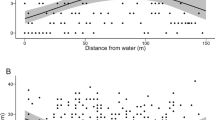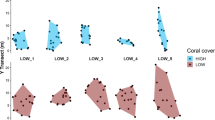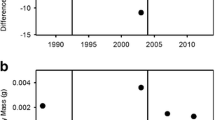Abstract
Invasive zebra mussels (Dreissena polymorpha) often colonize dragonfly larvae, especially spawling species whose survivorship to emergence as terrestrial predators is consequently reduced. Using individuals of the sprawler, Macromia illinoiensis, as their own controls, we compared the burying behavior of penultimate instar larvae before (i.e. baseline) and after their colonization by zebra mussels under ambient conditions. Individuals that took longer to bury themselves when mussel-free had a higher rate of colonization by mussels over a five-day period compared to those that buried faster. In contrast, the depth at which individuals buried when mussel-free was not predictive of subsequent colonization rate. Although mean bury time did not differ between baseline and when an individual carried one or more mussels, colonized larvae buried more shallowly than when mussel-free. Moreover, attached mussels increased the risk of subsequent colonization by zebra mussels. After naturally losing all of their attached mussels, bury time and depth of individuals did not differ from their baseline behavior, indicating that the changes in the behavior of colonized individuals were due to mussel loads and not their time in captivity. Under natural conditions, the positive feed-back between mussel attachment and increasing vulnerability to colonization helps explain how mussel loads, which are lost at molting, can accumulate quickly over the duration of the final larval stadium. Because zebra mussel attachment decreases the crypsis that that a M. illinoiensis gains from burying, the invasive mussel may also make dragonfly larvae more detectable to visual predators.







Similar content being viewed by others
References
Benson AJ, Raikow D, Larson J, Fusaro A (2012) Dreissena polymorpha. USGS Nonindigenous Aquatic Species Database, Gainesville, FL. http://nas.er.usgs.gov/queries/FactSheet.aspx?speciesID=5
Clarke M, McMahon RF (1996) Effects of temperature on byssal thread production by the freshwater mussel, Dreissena polymorpha (Pallas). Am Malacol Bull 13:105–110
Corbet PS (1999) Dragonflies: behavior and ecology of Odonata. Cornell University Press, Ithaca
Dall SRX, Houston LA, McNamara JM (2004) The behavioral ecology of personality: consistent individual differences from an adaptive perspective. Ecol Lett 7:734–739
Duckworth RA, Badyaeu AV (2007) Coupling of dispersal and aggression facilitates the rapid range expansion of a passerine bird. Proc Natl Acad Sci USA 104:15017–15022
Ďuriš Z, Horká I, Petrusek A (2007) Invasive zebra mussel colonisation of invasive crayfish: a case study. Hydrobiologia 590:43–46
Fincke OM, Santiago D, Hickner S, Bienek R (2009) Susceptibility of larval dragonflies to zebra mussel colonization and its effect on larval movement and survivorship. Hydrobiologia 624:71–79
Fincke OM, Tylczak LA (2011) Effects of zebra mussel attachment on the foraging behaviour of a larval dragonfly, Macromia illinoiensis. Ecol Entomol 36:760–767
Freeman AS, Byers JE (2006) Divergent induced responses to an invasive predator in marine mussel populations. Science 313:831–833
Garten CT, Gentry JB (1976) Thermal tolerance of dragonfly nymphs II: comparison of nymphs from control and thermally altered environments. Physiol Zool 49:206–213
Haag WR, Berg DJ, Garton DW, Farris JL (1993) Reduced survival and fitness in native bivalves in response to fouling by the introduced zebra mussel (Dreissena polymorpha) in western Lake Erie. Can J Fish Aquat Sci 50:13–19
Hebert PDN, Muncaster BW, Mackie GL (1989) Ecological and genetic studies on Dreissena polymorpha (Pallas) – a new mollusk in the Great Lakes. Can J Fish Aquat Sci 46:1587–1591
Langkilde T (2009) Invasive fire ants alter behavior and morphology of native lizards. Ecology 90:208–217
Lowe RL, Pillsbury RW (1995) Shifts in benthic algal community structure and function following the appearance of zebra mussels (Dreissena polymorpha) in Saginaw Bay, Lake Huron. J Great Lake Res 21:558–566
MacIsaac HJ (1996) Potential abiotic and biotic impacts of zebra mussels on the inland waters of North America. Am Zool 36:287–299
Mackie GL, Schloesser DW (1996) Comparative biology of zebra mussels in Europe and North America: an overview. Am Zool 36:244–258
McCauley SJ, Wehrly KE (2007) Zebra mussel, Dreissena polymorpha (Pallas), attachment to odonata larvae. Odonatologica 36:63–69
McMahon RF (1996) The physiological ecology of the zebra mussel, Dreissena polymorpha, in North America and Europe. Am Zool 36:339–363
Nagelkerke LAJ, Sibbing FA (1996) Efficiency of feeding on zebra mussel (Dreissena polymorpha) by common bream (Abramis brama), white bream (Blicca bjoerkna) and roach (Rutilus rutilus): the effects of morphology and behavior. Can J Fish Aquat Sci 53:2847–2861
Needham JG, Westfall MJ, May ML (2000) Dragonflies of North America. Scientific Publishers, Inc, Gainesville
Phillips BL, Shine R (2006) An invasive species induces rapid adaptive change in a native predator: cane toads and black snakes in Australia. Proc Roy Soc Lond B Biol Sci 273:1545–1550
Remsburg AJ, Turner MG (2009) Aquatic and terrestrial drivers of dragonfly (Odonata) assemblages within and among north-temperate lakes. J N Am Bentholl Soc 28:44–56
Schloesser DW, Nalepa TF (1994) Dramatic decline of unionid bivalves in offshore waters of western Lake Erie after infestation by the zebra mussel, Dreissena polymorpha. Can J Fish Aquat Sci 51:2234–2242
Schloesser DW, Nalepa TF, Mackie GL (1996) Zebra mussel infestation of unionid bivalves (Unionidae) in North America. Am Zool 36:300–310
Strayer DL, Malcom HM (2006) Long-term demography of a zebra mussel (Dreissena polymorpha) population. Freshwat Biol 51:117–130
Strayer DL, Caraco NF, Cole JJ, Findlay S, Pace MC (1999) Transformation of freshwater ecosystems by bivalves. Bioscience 49:19–27
Toomey MB, McCabe D, Marsden JE (2002) Factors affecting the movement of adult zebra mussels (Dreissena polymorpha). J N Am Bentholl Soc 21:468–475
Tucker JK, Camerer JB (1994) Colonization of the dragonfly, Gomphus vastus Walsh, by the zebra mussel, Dreissena polymorpha (Pallas) (Anisoptera: Gomphidae; - Bivalvia, Eulamellibranchia: Dreissenidae). Odonatologica 23:179–181
Van Appledorn M, Bach CE (2007) Effects of zebra mussels (Dreissena polymorpha) on mobility of three native mollusk species. Am Mid Nat 158:329–337
Weihrauch F, Borcherding J (2002) The zebra mussel, Dreissena polymorpha (Pallas), as an epizoon of anisopteran larvae (Anisoptera: Gomphidae, Corduliidae, Libellulidae). Odonatologica 31:85–94
West Eberhard MJ (2003) Developmental plasticity and evolution. Oxford University Press, New York
Wright TP, Eberhard JR, Hobson EA, Avery ML, Russello MA (2010) Behavioral flexibility and species invasions: the adaptive flexibility hypothesis. Ethol Ecol Evol 22:393–404
Zuk M, Simmons LW, Cupp L (1993) Calling characteristic of parasitized populations of the field cricket, Teleogrylla oceanicus. Behav Ecol Sociobiol 33:339–343
Acknowledgments
We thank the University of Michigan Biological Station for logistical support. This research was funded by National Science Foundation grant IBN-9408143 to O.M.F., and was the basis of an undergraduate honor thesis by M.E.H. at Wesleyan University, under the mentorship of Barry Chernoff.
Author information
Authors and Affiliations
Corresponding author
Rights and permissions
About this article
Cite this article
Hughes, M.E., Fincke, O.M. Reciprocal Effects between Burying Behavior of a Larval Dragonfly (Odonata: Macromia illinoiensis) and Zebra Mussel Colonization. J Insect Behav 25, 554–568 (2012). https://doi.org/10.1007/s10905-012-9323-y
Revised:
Accepted:
Published:
Issue Date:
DOI: https://doi.org/10.1007/s10905-012-9323-y




